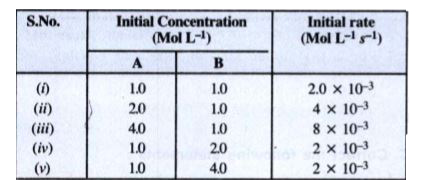At 600∘C, acetone (CH3COCH3) decomposes to ketene (CH2=C=O) and various hydrocarbons. Given the initial rate data in the table :
(a) What is the order ?
(b) Write rate law
(c) Calculate rate constant
(d) Calculate the rate of decomposition when the acetone concentration is 1.8×10–3M

(a) n=1, (b) dxdt=k[CH3COCH3], (c ) 8.67×10−3s−1 (d) 1.56×10−5Ms−1
Topper's Solved these Questions
- Chemical KineticsBOOK - MOTIONCHAPTER - Chemical KineticsEXERCISE - Exercise - 4 (Level - I)
18 Videos
- Chemical KineticsBOOK - MOTIONCHAPTER - Chemical KineticsEXERCISE - Exercise - 4 (Level - II)
15 Videos
- Chemical KineticsBOOK - MOTIONCHAPTER - Chemical KineticsEXERCISE - Exercise - 2 (Level-II) (COMPREHENSION - 5)
1 Videos
- CHEMICAL EQUILIBRIUMBOOK - MOTIONCHAPTER - CHEMICAL EQUILIBRIUMEXERCISE - Exercise - 4
20 Videos
- CLASSROOM PROBLEMS BOOK - MOTIONCHAPTER - CLASSROOM PROBLEMS EXERCISE - Electrochemistry
22 Videos
Similar Questions
Consider the reaction, A+B→C+D.
The initial rate for different initial concentrations of the reactants are given below :

Calculate the rate constant.
View SolutionConsider the reaction, A+B→C+D.
The initial rate for different initial concentrations of the reactants are given below :

Calculate the rate constant.
View SolutionConsider the reaction, A+B→C+D.
The initial rate for different initial concentrations of the reactants are given below :

Calculate the rate constant.
View SolutionThe rate of a first order reaction. A→B is 5.4×10−6Ms−1 when [A] is 0.3 M. Calculate the rate constant of the reaction
View SolutionThe following initial rate data were obtained at 300K for the reactions:
2A+B→C+D

Deducethe rate law.
View SolutionThe rate of change in concentration of C in the reaction 2A+B→2C+3D was 1.0molL−1S−1. Calculate the reaction rate as well as rate of change of concentration of A,B, and D
View SolutionThe rate of change in concentration of C in the reaction, 2A+B→2C+3D, was reported as 1.0 mol litre−1sec−1. Calculate the reaction rate as well as rate of change of concentration of A, B and D.
View SolutionIn the reaction A+2B→3C+2D, the rate of disappearance of B is 1×10−2molL−1s−1. What will be the rate of the reaction and rate of change in concentration of A and C?
View SolutionIn the given reaction A+3B →2C,the rate of formation of "C" is 2.5×10−4 mol L−1sec1calculate the
(a) Rate of reaction and
(b) Rate of disappearance of B
View SolutionIn the given reaction
A+3B→2C, the rate of formation of C is 2.5×10−4molL−1s−1.
Calculate the
(i) rate of reaction, and
(ii) rate of disapperance of B.
View Solution
